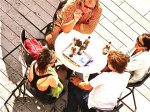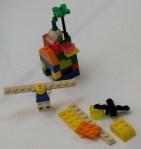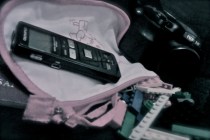May 20, 2016
The relationship between business and design has gone through deep changes in the past years. We are assisting at a convergence between business and design lead by the formalisation and adoption of design thinking and the revelation that good design is good business: many approaches from design have migrated into business and management enhancing the potential of business focused companies.
But there is a very special case of a method that was developed as an answer to a business need that has successfully migrated to design practices.
This is the case of Lego Serious Play: developed from the ’90s to improve the quality of strategic development meetings it has now been adopted by design companies to enhance creative processes, collaboration among different department, promote co-creation and participative design that includes customers, users, designers, and stakeholders.
Presented at #CassCreativity Seminar series on May 4th 2916, you can watch the whole Storyfy from this Link.
Posted in cocreation, Methodology, Organisations |
1 Comment »
June 20, 2014

© Patrizia Bertini
In the past few years, the number of articles published around Lego Serious Play is hugely increased.
The initial theories developed in the mid ’90s, 20 years ago, by Johan Ross and Bart Viktor and put into its current shape by Robert Rasmussen, are today converging and mingling with new trends and emerging needs.
What was supposed to simply be a language, communication tool, problem solving methodology, based on the belief that everyone can contribute to the discussion, the decisions, and the outcome, it has become a tool for exploring, both a crinkly and torn treasure map to be completed with the imagination of the facilitator and the participants, and a hammer to deconstruct and construct new opportunities.
read more »
Posted in LEGO SERIOUS PLAY, Methodology, theory |
3 Comments »
March 27, 2013
For those who were not there and for those who want to keep reflecting on the contents presented on Saturday 23rd March in Ferrara [Italy], here are the Keynote speakers’ presentation. A big thank you to all the speakers who agreed to share their precious and inspiring material!
Robert Rasmussen, Rasmussen Consulting (Denmark) | The LEGO SERIOUS PLAY method: a thinking, communication and problem solving techniques for groups insights to its the origin, purpose, functionality and theoretical underpinnings.
This slideshow requires JavaScript.
read more »
Posted in Architecture, education, Events & Fun, LEGO SERIOUS PLAY, theory |
1 Comment »
February 17, 2013

“For this feeling of wonder shows that you are a philosopher, since wonder is the only beginning of philosophy.” [Plato, Theaetetus]
When we want to know something, what we do is to search for reliable sources of information, to look for people who spent their lives studying a subject, trying to give it a sense, trying to make the topic understandable and clear and adding their own insights by formulating some statements which should define – and sometimes confine – the realm of knowledge we can get.
When we search for information, the first thing we rely on is the literature on the topic: we delve into books and papers, read, listen and watch everything relevant. Like sponges, we absorb what the world have already said and thought about the subject at hand, we take one or two of those main concepts, adopt them and elaborate our personal and critical insights starting from there.
We might end becoming experts and authorities on that subject with people asking us to explain the mysteries we already faced in the early stages of our research.
We build our knowledge step by step, brick by brick, by collecting information and combining it in something that fits the existent knowledge and our experience.
read more »
Posted in education, LEGO SERIOUS PLAY, Methodology |
2 Comments »
January 7, 2013

Lego Interviews produce new ideas
LEGO-interviews are an innovative investigative method to delve into reality developed by Patrizia Bertini starting from the basic theoretical principles of constructionism and from a deep knowledge and experience with underlying LEGO® SERIOUS PLAY® (LSP).
This interviewing method has been developed to challenge traditional journalism, as an attempt to explore the world through other people’s perception of reality and their views.
Journalistic interviews are generally based on well defined dynamics, on journalists’ capacity and on a constant tension between the interviewer and the interviewees. There is a large literature about this and there are experts who specifically train politicians and influent public people on how to handle and conduct interviews in order to dominate the conversation and to provide a good and safe image of themselves. And there are also a number of books and essays that teach journalists how to make effective interviwes. Everything is codified, recognisable and known.
LEGO-interviews’ challenge is that of radically changing the psychological and relational dynamics between the journalist and the interviewee so that the cognitive processes underlying the interaction are completely different: the interviewer and the interviewee are not anymore opponents but they collaborate, they literally construct the interview together with an original process that produces unexpected contents which most the time surprise the interviewees too.
read more »
Posted in Journalism, Methodology |
7 Comments »
January 5, 2012

My travelmates
I’ve spent 10 days traveling around Israel and Palestine. It was just me and my LEGO bricks, a pretty good company. I have met a lot of people, have talked to anyone, have tried to understand their world and the complex reality they live in.
I went there because I wanted to understand what the whole Israeli and Palestinian conflict was about: media all over the world constantly tell stories about what is going on, there are thousands of publications of all sorts and all parts. I was not able to make my mind, I wanted to explore such a complex reality and see what all that was about. And I wanted to do it my way, pushing the bricks further, trying to explore the reality Israeli and Palestinians experience every day. I was not interested in political talks or in the usual rhetoric speeches, I wanted to see the world these people experience with their eyes. I had no bias, since I could not embrace either of the extreme positions I had been reading about, and LEGO were a perfect mean – they offered me a method where my question could be neutral and unbiased, so that all the relevant issues would emerge spontaneously from the models interviewees would build.
[Read More]
Posted in Activism, Israel and Palestine, Journalism |
Leave a Comment »
December 24, 2011

Getting Ready for the Next Legoviews
Recently, one of the questions I’ve been asked the most is how did I come up with the idea of LegoViews. So, since it’s Christmas, it’s a good time for stories and here’s the story.
When I’ve started my PhD almost 3 years ago, I was obsessed with my ontological view and spent months trying to find the right approach to tackle my research questions. I ended up embracing Social Constructivism and in particular John Searle’s approach. But once I defined the theoretical framework, I needed to find a research method which were constructive enough and which could help me to highlight how social realities are built.
I spent a lot of time reflecting on methods, did my duties reading books and papers about the traditional methods used in social sciences: survey, interviews, focus groups… None of them was fitting enough into my idea – I wanted something more challenging and something which could explain and show the processes and which could materialize somehow the construction of social realities.
[Read More]
Posted in Methodology |
2 Comments »







